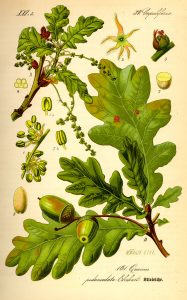Quercus robur
Dair ghallda

Prof. Dr. Otto Wilhelm Thomé Flora von Deutschland, Österreich und der Schweiz 1885, Gera, Germany, Illustration Quercus robur0, marked as public domain, more details on Wikimedia Commons
Pedunculate Oak is the less common of the two native Irish oak species. You can distinguish it from Sessile oak by looking at its acorns – pedunculate oak produces acorns on stalks.
The oak is one of our largest and longest lived trees – specimens typically live for up to 500 years, the oldest know Pedunculate Oak in Europe grows in Lithuania and is 1500 years old! They grow very quickly at first, but after reaching 100-200 years of age their growth rate slows down.
Native oak woods are important habitat for hundreds of invertebrates as well as many birds and mammals. The acorns are very rich in starch and tannins and are a great food source for all kinds of wildlife. Jays and squirrels are extremely important in dispersing acorns away from the parent tree – they bury them for later consumption and many of these acorns later germinate.
Featured image by David Hawgood (https://commons.wikimedia.org/wiki/File:Acorns_and_oak_leaves,_near_Thame_-_geograph.org.uk_-_228229.jpg), “Acorns and oak leaves, near Thame – geograph.org.uk – 228229”, https://creativecommons.org/licenses/by-sa/2.0/legalcode